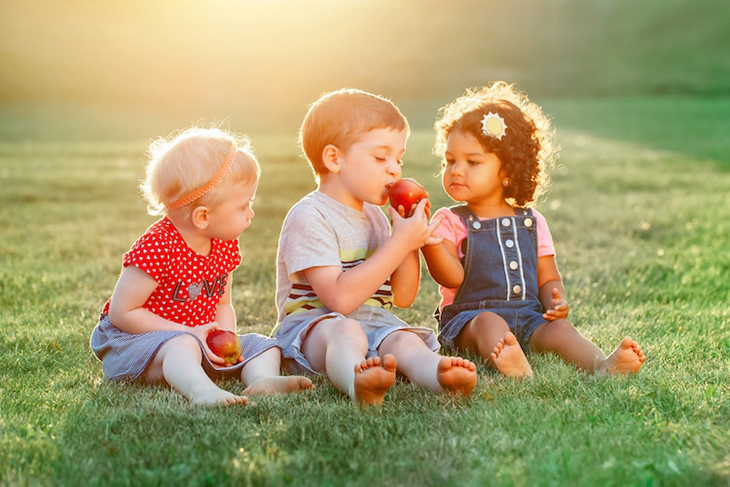New Study Says Babies See Kissing And Food Sharing As Signals To Understand Social Relationships

Social relationships are incredibly important, and they begin at birth. In order for people to navigate the world and survive in every day human society, they need to be able to handle social relationships. And when it comes to infants and younger children, this is done by understanding whom they can count on to take good care of them.
In a new study by MIT neuroscientists, they managed to identify a specific signal that infants and young kids use to figure out if two people have a strong relationship, as well as a ‘mutual obligation’ to help each other, and that’s by seeing whether they observe those two people either kissing, sharing food, or if they share saliva.
What the researchers discovered is that for babies, they actually expect those that share saliva will come to one another’s aid if that person happens to be under distress, and even more so than when those people share their toys or interact in ways that don’t involve the mouth or saliva.
Researchers say that what these findings show is that babies can actually use these cues to try and find out which people around them will most likely offer or provide help when needed.
According to John W. Jarve Professor of Brain and Cognitive Sciences, Rebecca Saxe, who is also a member of MIT’s McGovern Institute for Brain Research, “Babies don’t know in advance which relationships are the close and morally obligating ones, so they have to have some way of learning this by looking at what happens around them. Saxe also happens to be the senior author of this new study which was published in Science journal.
The Importance of Shared Saliva
In most human societies, relationships can be distinguished by the terms “thick” and “thin.” What this means is that for those with thick relationships, they are usually between those that are blood or family members that have very strong levels of obligation, attachment, and mutual responsiveness to one another. In fact, anthropologists have even observed that people with “thick” relationships are also those that are willing to share their bodily fluids, such as saliva.
Explained by study co-author Ashley J. Thomas, “That inspired both the question of whether infants distinguish between those types of relationships, and whether saliva sharing might be a really good cue they could use to recognize them.”
In order to better understand the questions, the research group also looked at toddlers between the ages of 16.5 to 18.5 months, as these toddlers watched interactions between human actors and puppets. During their first set of experiments, a puppet shared an orange with one actor, where a different actor tossed a ball back and forth.
After the toddlers were made to watch the initial interactions, the researchers observed how the children reacted when the puppet showed distress as he sat between the two actors. Much like a former study of nonhuman primates, the researchers observed that the babies would first look to the person whom they expected to help the primate in distress. So the study showed that when the baby monkeys cried, the other members of the group looked at the parents of the monkeys, like they were expecting them to do something.
Much like with the new study, the MIT team also found that the children were likelier to look at the actor who shared food with the puppet, rather than the one who shared a toy.
Then in another set of experiments, which was precisely designed to focus on saliva more, the actor was made to put her finger in her mouth, then into the mouth of the puppet. Or she placed her finger on her forehead, then onto the forehead of the puppet. Then later on, as the actor was made to show distress while standing between the two puppets, the children that were made to watch the video were also observed to look at the puppet that the actor shared the saliva with.
Observing Social Cues
What the findings suggest is that saliva sharing is quite likely an important cue that helps infants learn about their own social relationships and others around them, explain the researchers.
Thomas explained, “The general skill of learning about social relationships is very useful,” Thomas says. “One reason why this distinction between thick and thin might be important for infants in particular, especially human infants, who depend on adults for longer than many other species, is that it might be a good way to figure out who else can provide the support that they depend on to survive.”
The research group hopes to use functional magnetic resonance imaging (fMRI) in the future, to better look at the parts of the brain that are involved in making these making saliva-based assessments when it comes to social relationships.


